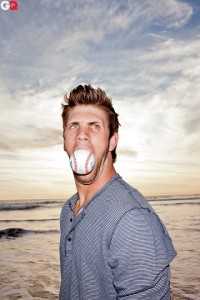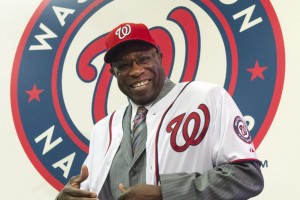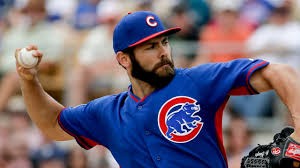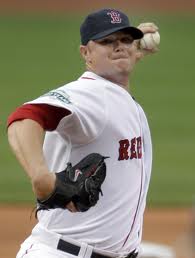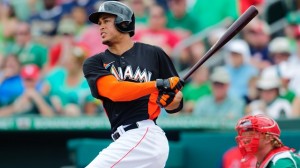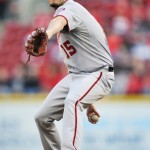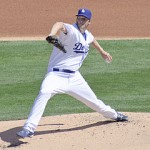Hey there! If its the Nat’s off-season, it must mean mail bag time. We havn’t seen one from MLB.com beat reporter Jamal Collier in a while (what, was he busy or something? 🙂 but now we get one with some good discussion-generating questions.
Here’s how i’d answer the questions he took.
Q: As a fan of the great outfield we had at the end of the year. Are the Nationals considering trading Adam Eaton if they resign Bryce Harper?
A: Indeed, an outfield of Soto, Eaton, and Harper is pretty awesome, if (biiiiig if) all are healthy and producing at optimal levels. And the on top of that we have a top-5 prospect in all of baseball Victor Robles who no longer can be kept in the minors. So that’s four solid players who all would start for any team in this league on one team. So what do we do?
Well … only one of these four guys is a Free Agent: Harper
And, only one of these guys is projected to make a ridiculous, franchise altering amount of money in free agency: Harper.
Harper has played for 7 nearly full-seasons: he has a total bWAR figure for his career is 27.4. That’s an average of 3.9 bWAR per season. Yes he had a monster 10 win season in his MVP season of 2015, but he’s also lost huge portions of several seasons to injury. And that has to be part of the conversation when you consider whether you commit $200M to him for the next 7 years.
For me the answer is easy. Juan Soto will make the MLB minimum (or near to it) next year; call it $600k. He generated 3.0 bWAR in 116 games, which projects to a 4.1 Win season with 162 games. I’d rather pay Soto $600k to give the team the same expected level of production as Harper would for 30-TIMES more money. You let Harper walk, you go to war in 2019 with Soto in left, Robles in center, Eaton in right, finally have three outfields all in the “right” positions defensively, and then deal with a 4th outfielder from internal candidates.
NOW. Letting a tranformative player like Harper go is … well its an “above the GM” decision. Not only because of the impact on payroll, but because of his role with the team. He’s a massively marketable star, transformative not just for the team but for the sport of professional baseball. His $30M/year salary (or whatever he wants) is not just about payroll; you can’t put a price tag on the marketability of a player of his stature and what it means for the team. He puts “butts in the seats.” He is in national commercial ad campaigns. He’s a foil (for better or for worse) across the sport. Do you just let a guy like this walk? They’re getting basically *nothing* back for him (a compensation pick between the 4th and 5th rounds, thanks to the criminally poor job the team did in managing the luxury cap over the last two years), so that barely factors into the discussion.
Now, lets say, for the sake of argument, that the team does re-sign Harper. Yeah for me, if you re-sign Harper, you’re going to have to move either Eaton or Robles. So … which do you move? Eaton, like Harper, has been just crushed by injury the last two years, producing a fraction of his value the 3 years prior. So even though he’s still quite affordable, trading him this off-season would be trading pretty low. Robles is still the unknown; yeah he’s an amazing prospect, but is he going to have a Juan Soto-like 2019? Robles can be the centerpiece of a trade that could return a significant player in an area of need for this team (mid-level Starter or quality starting Catcher). Would you prefer to go that route?
For me; i’m on record. I want to part ways with Harper, field a starting OF that costs less than half of a one-year Harper salary figure and allocate his projected payroll towards other areas of need.
Collier echos my concerns about trading Eaton low, but also notes that … well this is THE decision that the team faces, probably the biggest one in a decade. We can’t know until the Harper decision is made.
Q: What’s Michael A. Taylor’s future with this team?
A: For me, despite Michael Taylor‘ awesome 2017 season, he’s reverted back to form. He’s a 4th outfielder. Great defensively, poor offensively. Can play all three OF positions, plays CF excellently. But he still strikes out 33% of the time and cannot be trusted. After his 2018, its not like he has real trade value, and he’s now also arbitration eligible so he’s not exactly cheap. Is he a non-tender candidate? Probably not, but assuming the team goes with my plan of letting Harper walk and going with a starting OF of Soto-Robles-Eaton, then for me Taylor is an ideal 4th and competes in the spring with Andrew Stevenson for that role. He should win it, then be coupled with a corner-OF bench bat type who can play LF in a pinch.
Honestly, you learned everything you needed to know by looking at the amount of playing time Taylor got this past September once Robles came up. Almost none.
Now, if the team reasigns Harper? I don’t think much changes; the team moves either Eaton or Robles, still leaving Taylor as the 4th.
Collier thinks they’ll explore moving him “before his trade value falls anymore.” Uh … too late dude!
Q: Who are the free agent starting pitchers that Nationals will attempt to sign?
A: Taking a quick gander at the list of available starters … there’s all kinds of interesting names. Who knows who they may end up with.
Lets start with, what do they need? They’re keeping Scherzer, Strasburg, Roark, and Ross. They can either go to war with a 5th starter like Fedde or McGowin or Voth or Jefry Rodriguez, or look at free agency to improve the back end. I’d love to get a 3rd starter-quality guy to slot in behind the big two, then hope for a better season from Roark (something closer to 2016 than 2018), and hope for Ross to come back to what we know he’s capable of. That’s a potentially solid rotation for me.
We also might be focusing on a lefty, since Gio Gonzalez was our only lefty starter. But I don’t think that should be a huge factor honestly. The team needs to find the best value and availability.
I don’t see them pursuing a $20M/year guy. Not with the amount of money already going to their two #1 starters and certainly not given the possibilty of their re-signing Harper.
So, lets think about middle-of-the road lefty veteran starters. How about someone like a Jaime Garcia, or Hyung-Jin Ryu?
If they can’t land a lefty, there’s a slew of interesting names out there that are righties. I like Nathan Eovaldi, Wade Miley, Garrett Richards.
Collier hedges and says the obvious; we won’t know until they decide what they’re doing with Harper. Yeah i get it. He mentions that Patrick Corbin is probably out of the conversation (duh; he’ll be like the 4th most expensive player this off-season) and mentions re-upping with Jeremy Hellickson, which I don’t think happens b/c he pitched himself into a decent sized contract.. Its also worth mentioning; maybe the team goes the trade route, which opens up the realm of possibles to half the league’s starters if they’re willing to give up Robles or Carter Kieboom in trade.
Q: At what point will the Nats start looking for a more durable first baseman? Zim has averaged only 100 games a season over the last five years.
A: Uh, the second Ryan Zimmerman isn’t guaranteed 8 figures a year? And, by the way, what is this guy missing with the current roster construction? We were nearly to the point of an 1980s Orioles John Lowenstein/Gary Roenecke type platoon this year between Zimmerman and the lefty hitting Matt Adams. The team is already mitigating Zimmerna’s annual health issues with a backup.
And guess what? They’ll do it again this off-season. Look for the team to sign another Adams clone, someone like Lucas Duda or Steve Pearce or Pedro Alvarez. Heck, maybe they’ll re-sign Adams.
Collier basically says the same thing I did.
Q: Will Riz let Difo and Kieboom fight it out for 2b in spring training or will he look for a veteran 2b, using Kendrick in a super utility role?
A: The question probably should have read: “Wil Rizzo let Difo and Howie Kendrick fight it out…” Because Kieboom aint’ making this team in 2019. For one, he’s never played 2B professionally. Not that its a heavy lift going from SS to 2B (it isn’t) .. but he’s also just 60-some games removed from A-Ball. Kieboom needs to go from the AFL back to AA and return his OPS figures back to the .880 level before even being considered for AAA.
Honestly, I think the team goes with Kendrick (assuming he’s recovered from his bad achilles injury) as the starter, with Difo as the utility guy. Thanks to Kendrick’s injury and Daniel Murphy‘s prolonged recovery, Difo was essentially a starter this year. And he did not impress, his average dropping 40 points from where it was last year. I think that cements his status as a backup utility infielder who can cover middle infield positions in a pinch. I’m glad we have someone on the bench who can at least hit at a 75 OPS+ figure; lets not push it.
That being said, for me Kieboom is the future here. I think he might be ready after a half a season, and at that point you bring him up and slot him in at 2B. He could eventually move to 3B if the team cannot retain Anthony Rendon, or can stay at 2B and be a Jeff Kent-style slugger. I’d love to see that come together and have him join Soto and Robles as the core of the next generation of this team.
Collier thinks the team might look elsewhere for a starting 2B. I think they can make-do from within and not waste money chasing another Murphy replacement.
